SEO
Finding a Good Blog Niche (The Easy Way)

If you want to create a blog but don’t know where to start, it’s worth putting in some time to find a good blog niche. But how can you find one?
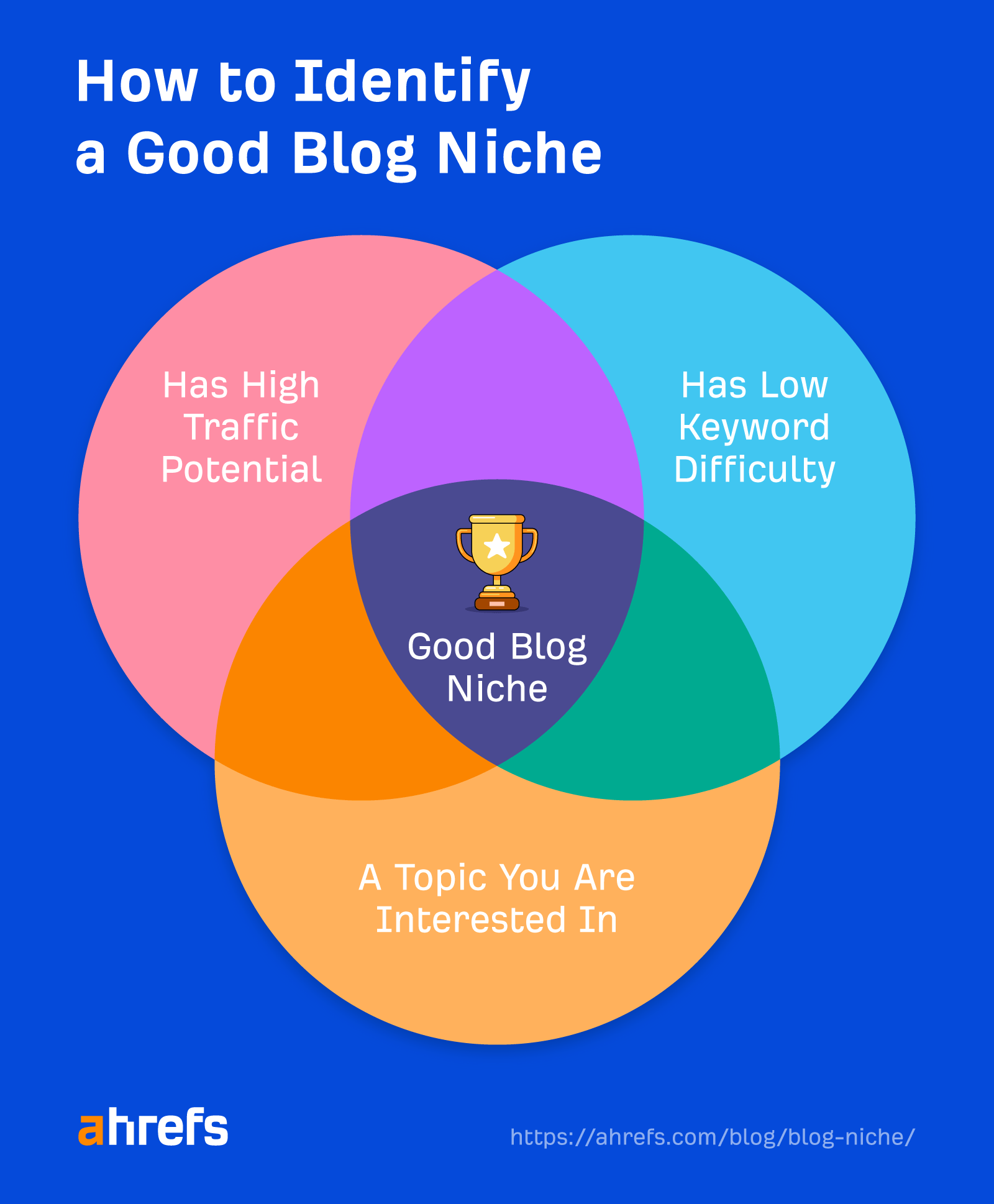
In my experience, identifying a good blog niche is usually determined by three things:
- It has high Traffic Potential. (TP estimates how much search traffic the top-ranking site gets for your keyword.)
- It has a low Keyword Difficulty. (KD estimates how difficult it would be to rank on the first page of Google for that keyword.)
- It’s a topic that interests you or you are an expert in.
If you can find a niche with these elements, it’s likely a good blog niche.
Sidenote.
This is a good starting point for most beginners when identifying a good blog niche. However, considering all the Ahrefs metrics before committing to a particular niche is always a good idea.
Using Keywords Explorer to find a good niche
The easiest way to identify a good niche is to use a tool like Ahrefs’ Keywords Explorer.
With this tool, you can plug in different keywords to see if they represent a workable blog niche opportunity.
Let’s say you’re a travel enthusiast with expert knowledge of Singapore and South Korea.
You want to write a guide about these topics but don’t know which one has more opportunities for organic search traffic. We can use keyword research to help determine the answer.
Let’s start by entering “singapore travel guide” into Keywords Explorer.
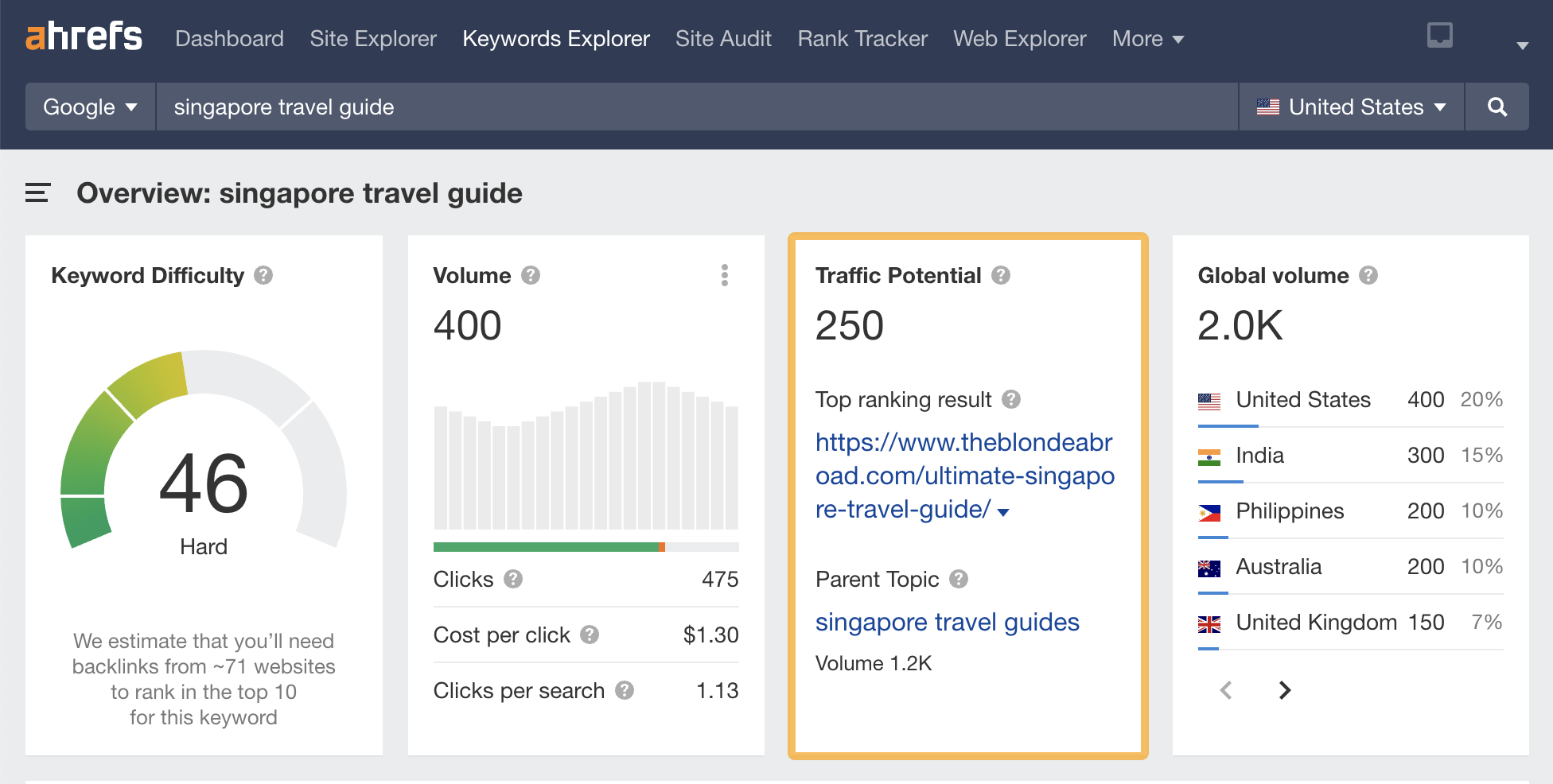
We can see that the TP for this keyword in the U.S. is 250—that’s quite low.
Since this keyword has a KD of 46, let’s plug in “south korea travel guide” into Keywords Explorer to compare these terms against each other.
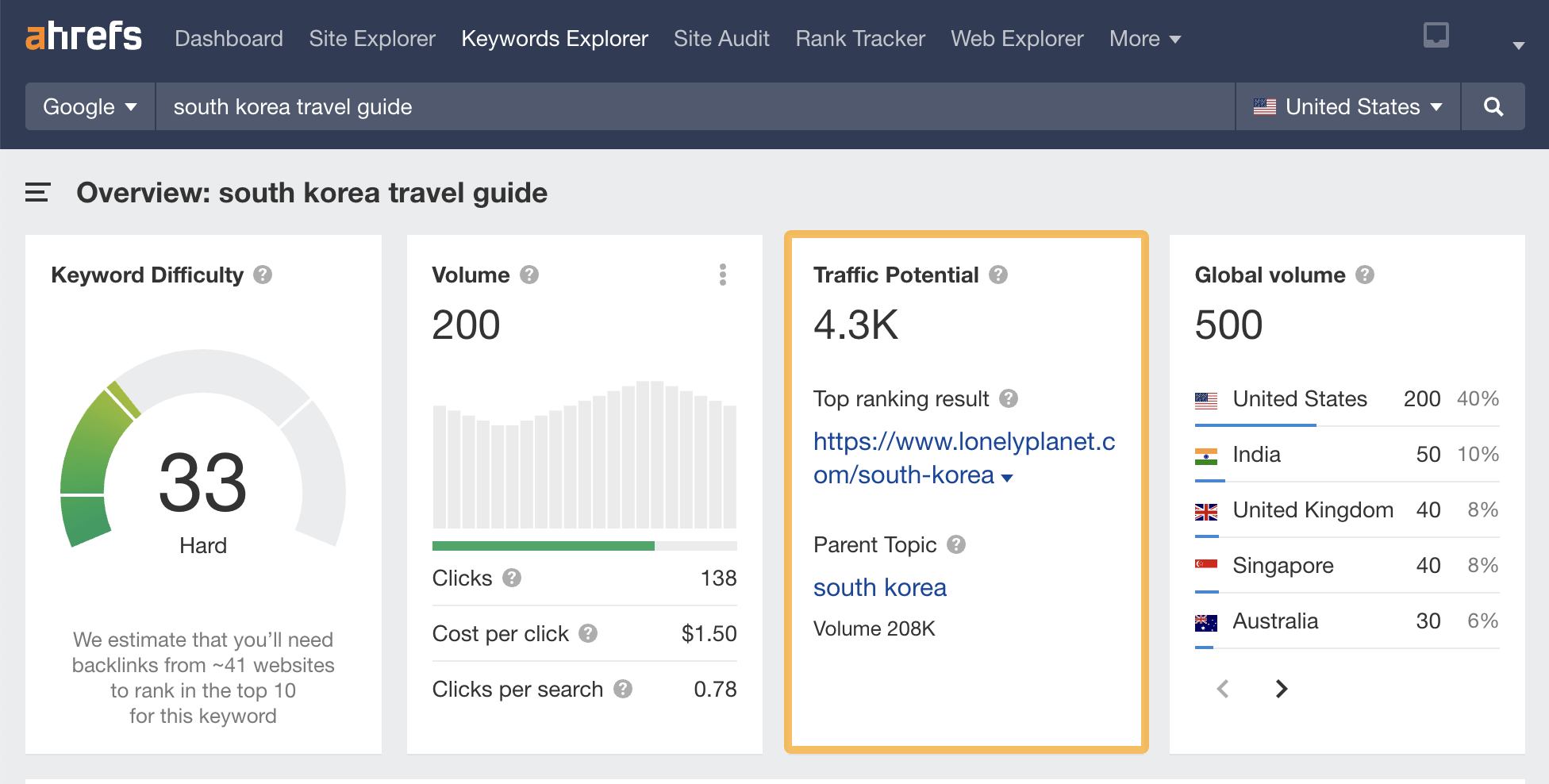
From this, we can see:
- The KD is lower for “south korea travel guide” than “singapore travel guide.”
- The TP is much higher for “south korea travel guide” at 4.3K.
This means there is ~17 times more TP for a South Korean travel guide than for a Singaporean travel guide.
A South Korean travel guide blog would also be easier to rank based on the KD scores.
Do note that Keywords Explorer estimates that we would need backlinks from ~41 websites to rank in the top 10 for this keyword—meaning it would take time for this site to rank on the first page.
If you have several potential topics for your blog, this method helps prioritize your blog niche ideas effectively.
Finding blog niche ideas that (probably) make money
Finding a good niche is one thing, but how do you know if it makes money?
Unfortunately, knowing exactly how much money a site makes is difficult unless you’re the site owner.
But we can get an idea of the estimated value of specific pages or even entire websites for different keywords using Ahrefs’ Keywords Explorer and Site Explorer. The metric we use to do this is organic traffic value.
Sidenote.
Organic traffic value is the equivalent monthly cost of traffic from all keywords that the target website/URL ranks for if paid via Pay Per Click instead of ranking organically.
Here’s a quick way to get the estimated organic traffic value of a page that ranks for a keyword:
- Enter your keyword into Keywords Explorer (e.g., “seoul travel blogs”)
- Scroll down to the SERP overview at the bottom of the page
- Estimated value of the page is shown on the right-hand side

You can enter the competitor’s website into Site Explorer to find the estimated organic traffic value.

In this example, I’ve entered the website’s domain, and we can see that the estimated monthly organic traffic value is $210K.
From this quick analysis, we can see that it’s likely a successful website.
You can also see how a blog niche is making money by looking at the top SERP results and understanding how the site owner is monetizing the website.
For instance, on the website we looked at, we can see that it’s monetized with Amazon Associates and Mediavine in the footer.

For Amazon, we can see the text disclosure. For Mediavine, we can see the Mediavine logo next to the advert.
Mediavine requires 50K sessions to apply, so this website is likely making a regular income.
If you want to take it further and only find Amazon Affiliate sites within your niche, you could use Ahrefs’ Web Explorer.
To do this, copy and paste the code below into Web Explorer to get a list of Amazon Affiliate websites:
incontent:is a participant in the Amazon Services LLC Associates Program AND outlinkdomain:amazon.com OR outlinkdomain:amzn.to
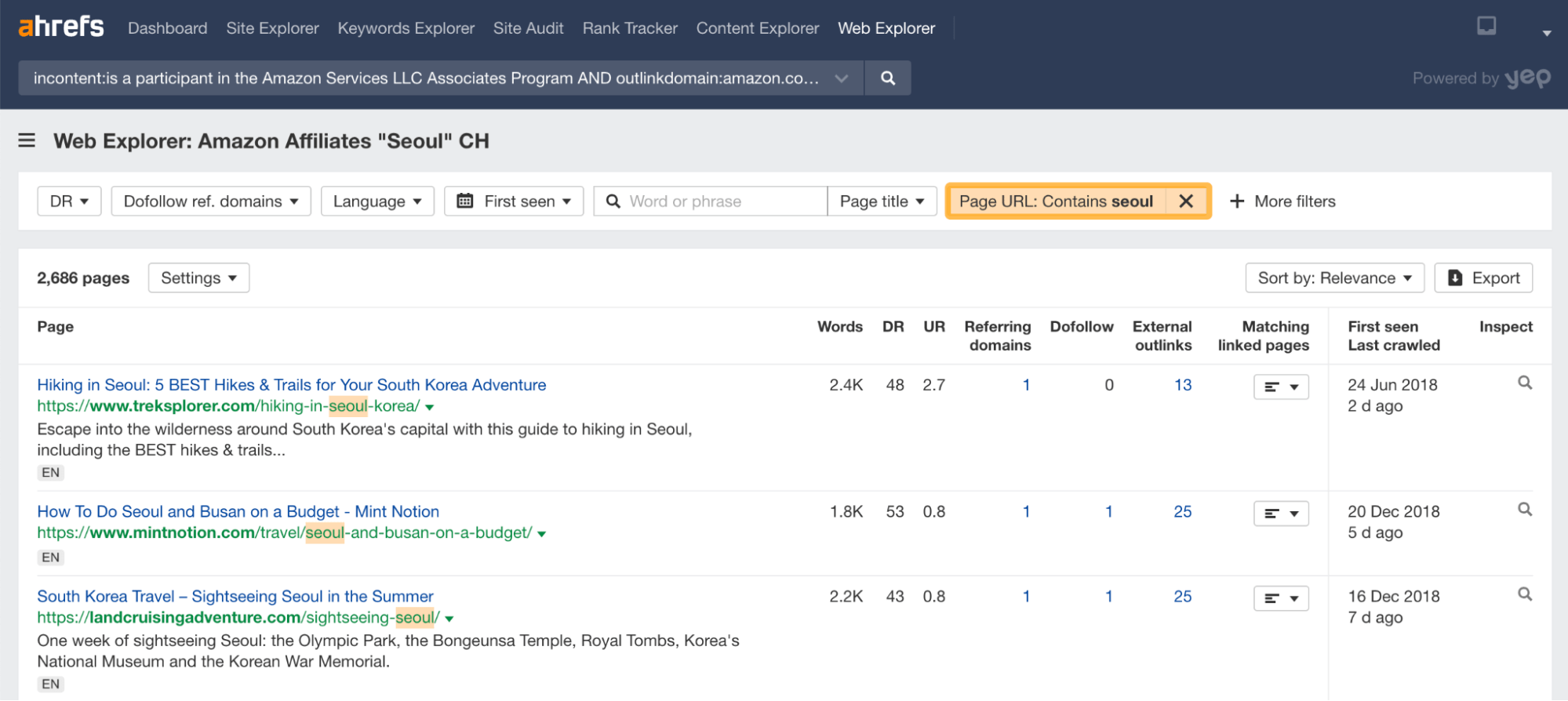
We can also add a filter to narrow our search to a specific niche. I’ve used a “Page URL” filter for Seoul-related keywords, but you can search for any niche you like here.
This isn’t a guarantee that the site is making money—but it can be a good indication.
Once you’ve identified a decent blog niche, the next stage is to develop your idea.
Here are some things you need to consider at this stage:
- What will the blog’s main pages be?
- What will the website’s architecture look like?
- What types of questions are people asking about this topic?
Finding the main pages of your blog
When deciding on the main pages of your website, the Matching terms report in Keywords Explorer is your friend.
I use “seoul” as my seed keyword in this example, and I want to set it to “By parent topic” and “Show as list.”
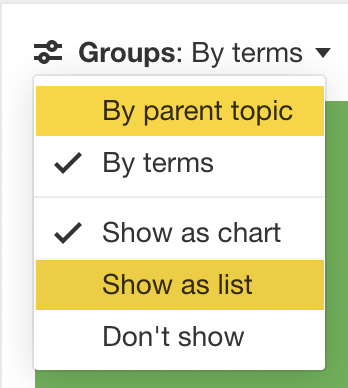

We see that the Parent Topics are listed by topic size.
Here are a few main pages I’ve picked from the above list that we can use for our blog:
- “things to do in seoul”
- “seoul food”
You can build a travel blog about these two topics, and we know from Keywords Explorer that these topics have plenty of search volume.
How to build out and define your website’s structure
To get an idea of how we can build out the website’s structure, you can use Ahrefs to spy on your competitors to see what’s already working in Google.
Let’s continue with our “seoul travel blogs” idea by clicking on the downward-facing caret result from SERP overview and clicking on “Overview” in the pop-up menu.
Doing this takes us to Site Explorer’s Overview report.

Once we are there, click on “Site structure” and change “Exact URL” to “Domain.”

Once we’ve done that, we can spy on the entire structure of the number #1 ranking site for this keyword phrase.

This is a powerful tactic, as it lets you understand what’s working on Google for other websites.
We can go further by adding a “URL” filter to show only URLs that contain “seoul” within this domain.
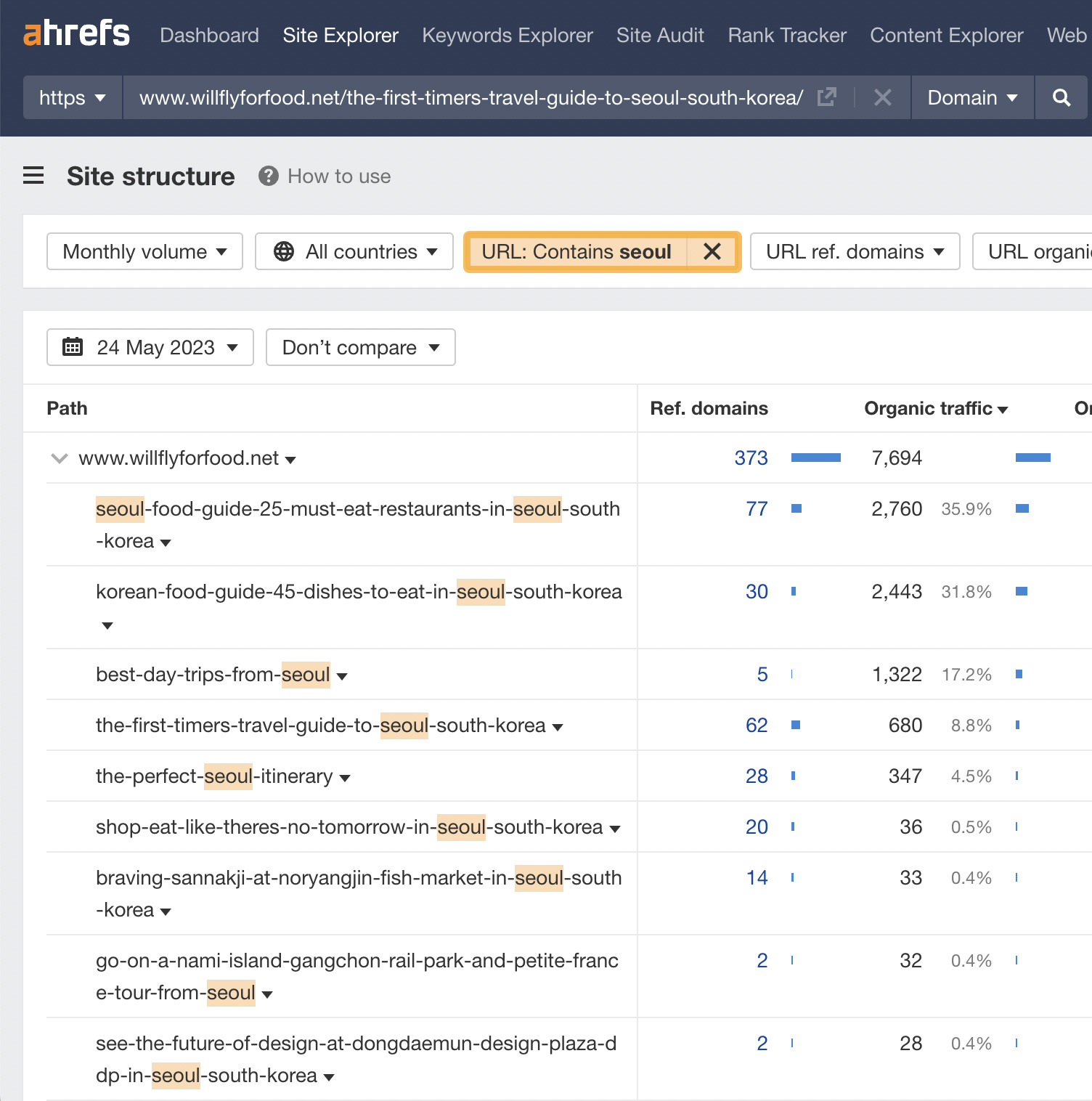
This can help us to understand what level of traffic this keyword is driving for this website. It also may inspire you to write about article topics that you hadn’t considered previously.
For example, we can see a lot of traffic related to food-based content in Seoul. If we had knowledge of this area, it could represent an excellent opportunity to cover these topics on your website.
Identifying popular questions in your blog niche
Finding questions in your blog niche is easy—here’s how you do it.
To start, enter your keyword into Keywords Explorer.
Then you’ll see the types of questions people are searching for in the bottom right-hand corner.

If you’ve read the first two sections, you should have a good idea of how to find a blog niche.
But if you’re short of time and looking for some instant ideas, I’ve identified 40 blog niche ideas. With some work, you could build a website around these for the U.S. market.
Health and fitness*
| Topic | Traffic Potential | Keyword Difficulty |
|---|---|---|
| Healthy restaurants | 43K | 8 |
| Meal plans to gain weight | 7.1K | 28 |
| Upper back pain | 35K | 34 |
| Stretches for sciatic pain | 92K | 20 |
Parenting
| Topic | Traffic Potential | Keyword Difficulty |
|---|---|---|
| Parenting advice for new parents | 2.8K | 17 |
| Traditional parenting styles | 9K | 37 |
| Raising children books | 3K | 20 |
| Positive parenting | 9.1K | 57 |
Personal finance*
| Topic | Traffic Potential | Keyword Difficulty |
|---|---|---|
| Money saving strategies | 14K | 77 |
| Budgeting advice | 22K | 69 |
| Financial planning | 4.7K | 73 |
| Budgeting plans | 22K | 86 |
Travel
| Topic | Traffic Potential | Keyword Difficulty |
|---|---|---|
| Budget family travel | 8.4K | 37 |
| Travel hacks | 2.8K | 31 |
| Traveling alone | 900 | 52 |
| Traveling with a baby | 2.1K | 38 |
Lifestyle
| Topic | Traffic Potential | Keyword Difficulty |
|---|---|---|
| How to live a better life | 3.2K | 48 |
| Decluttering | 6.7K | 57 |
| Relationship advice | 5.4K | 67 |
| Green living | 2.4K | 43 |
Food and kitchen
| Topic | Traffic Potential | Keyword Difficulty |
|---|---|---|
| Vegan and vegetarian recipes | 24K | 66 |
| Pescatarian diet | 7.4K | 55 |
| Kitchen organization | 8.5K | 67 |
| Kitchen gadgets | 8K | 50 |
DIY
| Topic | Traffic Potential | Keyword Difficulty |
|---|---|---|
| DIY furniture | 1.2K | 29 |
| Make your own clothing | 6.9K | 53 |
| Make your own crafts | 5K | 54 |
| Upcycling | 2K | 61 |
Beauty and fashion
| Topic | Traffic Potential | Keyword Difficulty |
|---|---|---|
| Makeup tutorials | 11K | 21 |
| Hair styling techniques | 2K | 6 |
| Skincare routine | 64K | 74 |
| Hair styling | 1K | 30 |
Self-help and motivation
| Topic | Traffic Potential | Keyword Difficulty |
|---|---|---|
| Visualization techniques | 2.3K | 43 |
| Manifestation | 8.8K | 59 |
| Personal growth examples | 1.7K | 34 |
| Self motivation affirmations | 18K | 8 |
Newborn and pregnancy*
| Topic | Traffic Potential | Keyword Difficulty |
|---|---|---|
| Newborn care | 400 | 49 |
| Pregnancy books | 1.4K | 19 |
| Baby gear | 2.9K | 37 |
| Baby sleep training | 5.9K | 58 |
Sidenote.
*Starred categories indicate a YMYL niche, which will likely be harder to rank for than other categories listed.
Final thoughts
Once you’ve chosen your blog niche, there’s still more work ahead—you’ll need to do these things to ensure your website’s success:
Choosing a successful blog niche isn’t always straightforward. But if you have Ahrefs, much of the guesswork is removed, and you can use our data to help make the decisions.
Got more questions? Ping me on Twitter. 🙂
SEO
Google Declares It The “Gemini Era” As Revenue Grows 15%

Alphabet Inc., Google’s parent company, announced its first quarter 2024 financial results today.
While Google reported double-digit growth in key revenue areas, the focus was on its AI developments, dubbed the “Gemini era” by CEO Sundar Pichai.
The Numbers: 15% Revenue Growth, Operating Margins Expand
Alphabet reported Q1 revenues of $80.5 billion, a 15% increase year-over-year, exceeding Wall Street’s projections.
Net income was $23.7 billion, with diluted earnings per share of $1.89. Operating margins expanded to 32%, up from 25% in the prior year.
Ruth Porat, Alphabet’s President and CFO, stated:
“Our strong financial results reflect revenue strength across the company and ongoing efforts to durably reengineer our cost base.”
Google’s core advertising units, such as Search and YouTube, drove growth. Google advertising revenues hit $61.7 billion for the quarter.
The Cloud division also maintained momentum, with revenues of $9.6 billion, up 28% year-over-year.
Pichai highlighted that YouTube and Cloud are expected to exit 2024 at a combined $100 billion annual revenue run rate.
Generative AI Integration in Search
Google experimented with AI-powered features in Search Labs before recently introducing AI overviews into the main search results page.
Regarding the gradual rollout, Pichai states:
“We are being measured in how we do this, focusing on areas where gen AI can improve the Search experience, while also prioritizing traffic to websites and merchants.”
Pichai reports that Google’s generative AI features have answered over a billion queries already:
“We’ve already served billions of queries with our generative AI features. It’s enabling people to access new information, to ask questions in new ways, and to ask more complex questions.”
Google reports increased Search usage and user satisfaction among those interacting with the new AI overview results.
The company also highlighted its “Circle to Search” feature on Android, which allows users to circle objects on their screen or in videos to get instant AI-powered answers via Google Lens.
Reorganizing For The “Gemini Era”
As part of the AI roadmap, Alphabet is consolidating all teams building AI models under the Google DeepMind umbrella.
Pichai revealed that, through hardware and software improvements, the company has reduced machine costs associated with its generative AI search results by 80% over the past year.
He states:
“Our data centers are some of the most high-performing, secure, reliable and efficient in the world. We’ve developed new AI models and algorithms that are more than one hundred times more efficient than they were 18 months ago.
How Will Google Make Money With AI?
Alphabet sees opportunities to monetize AI through its advertising products, Cloud offerings, and subscription services.
Google is integrating Gemini into ad products like Performance Max. The company’s Cloud division is bringing “the best of Google AI” to enterprise customers worldwide.
Google One, the company’s subscription service, surpassed 100 million paid subscribers in Q1 and introduced a new premium plan featuring advanced generative AI capabilities powered by Gemini models.
Future Outlook
Pichai outlined six key advantages positioning Alphabet to lead the “next wave of AI innovation”:
- Research leadership in AI breakthroughs like the multimodal Gemini model
- Robust AI infrastructure and custom TPU chips
- Integrating generative AI into Search to enhance the user experience
- A global product footprint reaching billions
- Streamlined teams and improved execution velocity
- Multiple revenue streams to monetize AI through advertising and cloud
With upcoming events like Google I/O and Google Marketing Live, the company is expected to share further updates on its AI initiatives and product roadmap.
Featured Image: Sergei Elagin/Shutterstock
SEO
brightonSEO Live Blog

Hello everyone. It’s April again, so I’m back in Brighton for another two days of Being the introvert I am, my idea of fun isn’t hanging around our booth all day explaining we’ve run out of t-shirts (seriously, you need to be fast if you want swag!). So I decided to do something useful and live-blog the event instead.
Follow below for talk takeaways and (very) mildly humorous commentary. sun, sea, and SEO!
SEO
Google Further Postpones Third-Party Cookie Deprecation In Chrome

Google has again delayed its plan to phase out third-party cookies in the Chrome web browser. The latest postponement comes after ongoing challenges in reconciling feedback from industry stakeholders and regulators.
The announcement was made in Google and the UK’s Competition and Markets Authority (CMA) joint quarterly report on the Privacy Sandbox initiative, scheduled for release on April 26.
Chrome’s Third-Party Cookie Phaseout Pushed To 2025
Google states it “will not complete third-party cookie deprecation during the second half of Q4” this year as planned.
Instead, the tech giant aims to begin deprecating third-party cookies in Chrome “starting early next year,” assuming an agreement can be reached with the CMA and the UK’s Information Commissioner’s Office (ICO).
The statement reads:
“We recognize that there are ongoing challenges related to reconciling divergent feedback from the industry, regulators and developers, and will continue to engage closely with the entire ecosystem. It’s also critical that the CMA has sufficient time to review all evidence, including results from industry tests, which the CMA has asked market participants to provide by the end of June.”
Continued Engagement With Regulators
Google reiterated its commitment to “engaging closely with the CMA and ICO” throughout the process and hopes to conclude discussions this year.
This marks the third delay to Google’s plan to deprecate third-party cookies, initially aiming for a Q3 2023 phaseout before pushing it back to late 2024.
The postponements reflect the challenges in transitioning away from cross-site user tracking while balancing privacy and advertiser interests.
Transition Period & Impact
In January, Chrome began restricting third-party cookie access for 1% of users globally. This percentage was expected to gradually increase until 100% of users were covered by Q3 2024.
However, the latest delay gives websites and services more time to migrate away from third-party cookie dependencies through Google’s limited “deprecation trials” program.
The trials offer temporary cookie access extensions until December 27, 2024, for non-advertising use cases that can demonstrate direct user impact and functional breakage.
While easing the transition, the trials have strict eligibility rules. Advertising-related services are ineligible, and origins matching known ad-related domains are rejected.
Google states the program aims to address functional issues rather than relieve general data collection inconveniences.
Publisher & Advertiser Implications
The repeated delays highlight the potential disruption for digital publishers and advertisers relying on third-party cookie tracking.
Industry groups have raised concerns that restricting cross-site tracking could push websites toward more opaque privacy-invasive practices.
However, privacy advocates view the phaseout as crucial in preventing covert user profiling across the web.
With the latest postponement, all parties have more time to prepare for the eventual loss of third-party cookies and adopt Google’s proposed Privacy Sandbox APIs as replacements.
Featured Image: Novikov Aleksey/Shutterstock
-
SEARCHENGINES6 days ago
Daily Search Forum Recap: April 19, 2024
-

 WORDPRESS7 days ago
WORDPRESS7 days agoHow to Make $5000 of Passive Income Every Month in WordPress
-

 WORDPRESS6 days ago
WORDPRESS6 days ago13 Best HubSpot Alternatives for 2024 (Free + Paid)
-

 MARKETING6 days ago
MARKETING6 days agoBattling for Attention in the 2024 Election Year Media Frenzy
-

 WORDPRESS6 days ago
WORDPRESS6 days ago7 Best WooCommerce Points and Rewards Plugins (Free & Paid)
-

 AFFILIATE MARKETING7 days ago
AFFILIATE MARKETING7 days agoAI Will Transform the Workplace. Here’s How HR Can Prepare for It.
-

 MARKETING5 days ago
MARKETING5 days agoAdvertising in local markets: A playbook for success
-

 SEO6 days ago
SEO6 days agoGoogle Answers Whether Having Two Sites Affects Rankings















